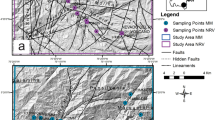Abstract
In unconventional reservoirs, small faults allow the flow of oil and gas as well as act as obstacles to exploration; for, (1) fracturing facilitates fluid migration, (2) reservoir flooding, and (3) triggering of small earthquakes. These small faults are not generally detected because of the low seismic resolution. However, such small faults are very active and release sufficient energy to initiate a large number of microseismic events (MEs) during hydraulic fracturing. In this study, we identified microfractures (MF) from hydraulic fracturing and natural small faults based on microseismicity characteristics, such as the time–space distribution, source mechanism, magnitude, amplitude, and frequency. First, I identified the mechanism of small faults and MF by reservoir stress analysis and calibrated the ME based on the microseismic magnitude. The dynamic characteristics (frequency and amplitude) of MEs triggered by natural faults and MF were analyzed; moreover, the geometry and activity types of natural fault and MF were grouped according to the source mechanism. Finally, the differences among time–space distribution, magnitude, source mechanism, amplitude, and frequency were used to differentiate natural faults and manmade fractures.
Similar content being viewed by others
References
Aki, K., 1967, Scaling lay of seismic spectrum: Journal of Geophysical Research, 72(4), 1217–1231.
Aki, K., 1968, Seismic displacement near a fault: J. Geophys. Res., 73, 5359–5371.
Aki, K., 1979, Characterization of barriers on an earthquake fault: Geophysical Research Atmospheres, 84(B11), 6140–6148.
Aki, K., 2010, Scaling law of earthquake source time function: Geophysical Journal International, 31(1–3), 3–25.
Cipolla, C. L., Warpinski, N. R., Mayerhofer, M. J., et al., 2010, The relationship between fracture complexity, reservoir properties, and fracture treatment design: SPE Production & Operation, 25(4), 438–452.
Dahi, T. A., Gonzalez, M., Puyang, P., et al., 2013, Posttreatment assessment of induced fracture networks: SPE Annual Technical Conference and Exhibition, SPE, 30 September-2 October, New Orleans, Louisiana, USA, SPE 166354, 1–12.
Fischer, T., 2005, Modeling of multiple events using empirical Green's functions:method, application to swarm earthquakes and implications for their rupture propagation: Geophy. J. Int, 163, 991–1005.
Gutenberg, B., 1945a, Amplitude of surface waves and magnitude of shallow earthquake: Bull. Seism. Soc. Am, 35, 3–12.
Gutenberg, B., 1945b, Amplitudes of P, PP and S and magnitude of shallow earthquakes: Bull. Seism. Soc. Am, 35, 57–69.
Gutenberg, B., 1945c, Magnitude determination for deepfocus earthquakes: Bull Seism Soc Am, 35, 117–130.
Jane, L., 2013, Microseismic Case Study: Investigating the Natural Fractures and Faults of the Muskwa & Evie Shale Play in Northeastern British Columbia: 83th Annual International Meeting, SEG, Expand Abstract, 2135–2139.
Jo, E. K., Leo E., Sherilyn, E. S., et al., 2010, Natural Fracture Characterization from Microseismic Source Mechanisms: A Comparison with FMI Data: 80th Annual International Meeting, SEG, Expand Abstracts, 2110–2114.
Kikuchi, M., and Kanamori, H., 1986, Inversion of complex body waves-III: Physics of The Earth and Planetary Interiors, 43(3), 205–222.
Kikuchi, M., and Kanamori, H., 1991, Inversion of complex body waves-III: Bull. Seism. Soc. Am., 81, 2335–2350.
Lei, J., and Mark, Z., 2015, Identification of fault-controlled damage zones in microseismic data - an example from the Haynesville shale: 85th Annual International Meeting, SEG, Expand Abstract, 726–730.
Maxwell, S. C., Jones, M., Parker, R., et al., 2009, Fault Activation During Hydraulic Fracturing: 79th Annual International Meeting, SEG, Expand Abstract, 1152–1156.
Ping, P., Taleghani, A. D., and Sarker, B., 2016, An integrated modeling approach for natural fractures and posttreatment fracturing analysis: A case study: Interpretation, 4(4), T493–T504.
Potluri, N. K., Zhu, D., and Hill, A. D., 2005, The effect of natural fractures on hydraulic fracture propagation: SPE Annual Technical Conference and Exhibition, 25–27 May, Netherlands, SPE 166354, 1–6.
Richter, C. F., 1935, An instrumental earthquake magnitude scale: Bulletin of the Seismological Society of America, 25(1–2), 1–32.
Seth, S., and Michael, W., 2003, An introduction to Seismology Earthquakes and Earth Structure: Blackwell Publishing Ltd, UK, 215–278.
Wu, Y. Y., 2013, Earthquake fault identification method and its application: MSc. Thesis, Southwest University of Science and Technology.
Yi, Y., and Mark, D. Z., 2014, The role of preexisting fractures and faults during multistage hydraulic fracturing in the Bakken Formation: Interpretation, 2(3), SG25–SG39.
Yin, C., He, Z. H., Li, Y. L., et al., 2015, Research and application of the relative magnitude technique based on microseism: Chinese J. Geophys. (in Chnese), 58(6), 2210–2220.
Yin, C., Liu, H., Wu, F. R., et al., 2013, The effect of the calibrated velocity on the microseismic event location precision: 83th Annual International Meeting, SEG, Expand Abstract, 1977–1981.
Zhang, Y., 2008, Study on the Inversion Methods of source rupture process: PhD Thesis, Beijing University.
Zhu, L., 2012, Fracture Character and Distribution Evaluation of Fracture in Xuer, Xinchang area: MSc. Thesis, Chengdu University of Technology.
Acknowledgements
The author wishes to thank the members of the microseismic research group at the Sichuan Geophysical Company. The suggestions of Profs. Huang Xuri, Wang Runqiu, and others are appreciated; however, I bear full responsibility of the arguments and conclusions.
Author information
Authors and Affiliations
Corresponding author
Additional information
This work was supported by the National Key Research and Development Project of China (No. 2016ZX05023-004).
Yin Chen received her M.S. in Geophysics (2008) from Chengdu University of Technology. She is presently an engineer in the CNPC Sichuan Geophysical company, working on microseismic monitoring techniques and software evelopment.
Rights and permissions
About this article
Cite this article
Yin, C. Fault detection based on microseismic events. Appl. Geophys. 14, 363–371 (2017). https://doi.org/10.1007/s11770-017-0631-z
Received:
Revised:
Published:
Issue Date:
DOI: https://doi.org/10.1007/s11770-017-0631-z




